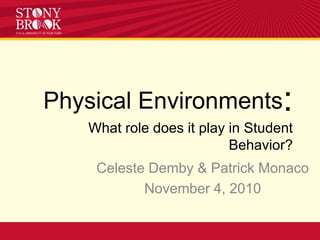
Physical Environments
- 1. Physical Environments:What role does it play in Student Behavior? Celeste Demby & Patrick Monaco November 4, 2010
- 6. Architectural Possibilism: Views the physical environment as a source of opportunities that may set limits on, but not restrict, behavior.
- 7. Architectural Probabilism: emerged to capture the probabilistic relationship between physical environment and behavior(Strange & Banning, 2001) Influence of the physical environment has three distinct positions:
- 8. The Campus Tour (Sturner, 1973; Thelin & Yankovich, 1987) Physical features are often amongst the most important factors in creating a critical first impression of an institution
- 9. Safety and inclusion are related being that they are both impacted by campus conditions considered to be requisites for learning and development Promoting Safety and Inclusion (Strange & Banning, 2001)
- 10. Both the location of a building and room within the building have an impact of crime and vandalism on campus. Promoting Safety and Inclusion
- 11. Behavioral zoning is critical in the design of a building. Spaces with in the building need to have specific functions that meet students needs. -Recreation rooms -Cafeterias -Study lounges -Lounges (Strange & Banning, 2001)
- 12. Before involvement and community building can occur students must feel safe. Without this all advanced learning goals will most likely fail. Promoting Safety and Inclusion (Strange, 2003)
- 14. Small rural campus vs. Large Urban campus
- 16. Human scale environments are not over-crowded, blend in with the natural surroundings, and accommodate small numbers of people in structures usually no more than three stories above the ground.
- 18. Spaces that encourage individuals to spend time interacting with others are described as “sociopetal” or “socially catalytic” spaces. Kuh et al.(1991)Encouraging Involvement
- 19. Encouraging Involvement Strange and Banning (2003) The physical environment can contribute to college student learning and development in two important ways:
- 20. The actual features of the physical environment can encourage or discourage the process of learning and development Encouraging Involvement Strange and Banning (2003)
- 21. The process of designing campus physical environments can also promote the acquisition of skills important to the process of learning and developing. Encouraging Involvement Strange and Banning (2003)
- 22. Ex) George Mason University’s Johnson Center Fairfax, VA “It’s where the action is. Students flock there for the food, the library, the bookstore, the multimedia facilities, special events, or just for social interaction” Encouraging Involvement (Misenick, O’Connor, and Young, 2005) The physical artifact message of support or non support can take many forms, signaling a sense of belonging and a feeling of being welcomed, a sense of safety, and a sense of role, worth, and value (Banning & Bartels, 1993)
- 23. Encouraging Involvement GMU’s Johnson Center Built to encourage learning through spatial design
- 24. Building Community (Pascarella, Terenzini, and Bliming 1994). Students living on campus are more likely to have increased social interactions with peers and faculty as well as become more involved on campus
- 25. Building Community (Strange and Banning, 2004) By nature communities tend to be territorial. Students want to create a sense of community and the feeling of being at home.
- 26. Building Community (Evans & McCoy, 1998) Buildings with a design that includes varying levels of stimulus isolation will allow the individual to have more control over their socialization. The design of the building should include spaces that promote solitude or intimacy, small group interaction, and promote contact with others.
- 27. Building Community (Evans and McCoy 1998) The arrangement of the furniture within a physical space can have an impact on the potential of social interaction. Furniture that is easily movable, provides a level of comfortable personal space, promotes eye contact, and has a comfortable design contributes to the overall social experience.
- 28. Building Community (Evans & McCoy, 1998) Buildings with a design that includes varying levels of stimulus isolation will allow the individual to have more control over their socialization. The design of the building should include spaces that promote solitude or intimacy, small group interaction, and promote contact with others.
- 29. A Hierarchy of Learning Environment Purposes Strange and Banning (2001) Community (Full Membership) Involvement (Participation, Engagement, Role-Taking) Safety and Inclusion (Sense of belonging and Security)
